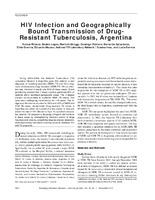Please use this identifier to cite or link to this item:
http://sgc.anlis.gob.ar/handle/123456789/1393| Title: | HIV infection and geographically bound transmission of drug-resistant tuberculosis, Argentina | Authors: | Ritacco, Viviana López, Beatriz Ambroggi, Marta Palmero, Domingo Salvadores, Bernardo Gravina, Elida Mazzeo, Eduardo Imaz, María Susana Barrera, Lucía |
Issue Date: | Nov-2012 | Journal: | Emerging infectious diseases | Abstract: | During 2003-2009, the National Tuberculosis (TB) Laboratory Network in Argentina gave 830 patients a new diagnosis of multidrug-resistant (MDR) TB and 53 a diagnosis of extensively drug- resistant (XDR) TB. HIV co-infection was involved in nearly one third of these cases. Strain genotyping showed that 7 major clusters gathered 56% of patients within restricted geographic areas. The 3 largest clusters corresponded to epidemic MDR TB strains that have been undergoing transmission for >10 years. The indigenous M strain accounted for 29% and 40% of MDR and XDR TB cases, respectively. Drug-resistant TB trends in Argentina are driven by spread of a few strains in hotspots where the rate of HIV infection is high. To curb transmission, the national TB program is focusing stringent interventions in these areas by strengthening infection control in large hospitals and prisons, expediting drug resistance detection, and streamlining information-sharing systems between HIV and TB programs. |
URI: | http://sgc.anlis.gob.ar/handle/123456789/1393 | DOI: | 10.3201/eid1811.120126 |
| Appears in Collections: | Publicaciones INEI |
Files in This Item:
| File | Description | Size | Format | |
|---|---|---|---|---|
| 12-0126.pdf | Artículo en inglés | 321.32 kB | Adobe PDF |  View/Open |
Page view(s)
107
checked on Dec 16, 2025
Download(s)
30
checked on Dec 16, 2025
Google ScholarTM
Check
Altmetric
Altmetric
Items in DSpace are protected by copyright, with all rights reserved, unless otherwise indicated.

